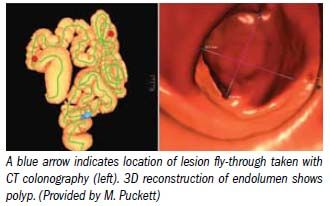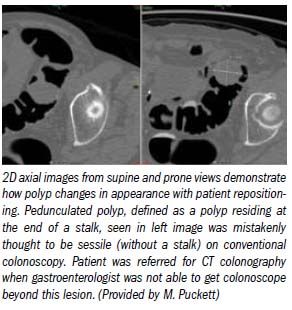Two sites show how to make CTC clinically routine
In the seven years since he came to Madison, Dr. Perry Pickhardt has done 7000 CT colonographies at the University of Wisconsin. Dr. Michael Puckett has been similarly successful in private practice with the San Diego Medical Imaging Group.
In the seven years since he came to Madison, Dr. Perry Pickhardt has done 7000 CT colonographies at the University of Wisconsin. Dr. Michael Puckett has been similarly successful in private practice with the San Diego Medical Imaging Group.
Each has taken a distinct approach to making CT colonography part of the clinical routine, Pickhardt reaching out to third-party payers and Puckett reaching out to gastroenterologists.

The two once worked side by side at the Bethesda Naval Hospital in Maryland. Together they were part of a research team that clearly documented for the first time the clinical viability of CT colonography (NEJM 2003;349[23]:2191-2200).
After leaving the U.S. Navy’s flagship medical center in 2002, Pickhardt joined the UW, home to one of the country’s largest teaching hospitals. To build his practice, he reached out to third-party payers in the Madison area, demonstrating the utility of CT colonography as a routine way to screen patients for colorectal cancer.
“We are the only program in the country that has this third-party payer coverage specifically for screening,” said Pickhardt, a professor of radiology and chief of gastrointestinal imaging at the UW.
Puckett chose a different route, joining a private radiology practice that serves four hospitals and two imaging centers in the San Diego area. To forward his goal of pushing CT colonography into the clinical mainstream, he sought alliances with local gastroenterologists. He provides CT colonography to patients who cannot complete optical exams, as well as those who, for one reason or another, prefer a less invasive approach.
“Almost all my patients are referred by gastroenterologists,” said Puckett, a diagnostic radiologist with San Diego Imaging Medical Group. “They have come to know me and know what I can do.”
The mystery behind the performance of CT colonography has faded with peer-reviewed publications and presentations on the underlying technique at scientific conferences.
“There is still some variability,” Puckett said. “Everyone has their own secret sauce, their own way of doing things. Workstations are different. The preps are a little different. But that being said, it has gotten to the point where uniformly good quality exams are being done.”
Low-dose protocols, ones much lower than most CT scans, produce a 3D fly-through of the colon and rectum. The procedure has proven as accurate as standard colonoscopy in clinical trials and in a study by the Blue Cross Blue Shield Technology Evaluation Center.
This work has smoothed the path to reimbursement as third party payers, including Anthem Blue Cross Blue Shield, Cigna, and United Healthcare, have climbed aboard to cover screening and diagnostic applications. Although Medicare patients continue to be denied coverage, they are not the prime patient population, Pickhardt said.

“We are really focusing on 50 to 65-year-olds,” he said. “The shame of it is that a lot of insurers are using a lack of CMS coverage as the reason for not covering virtual colonoscopy.”
CT colonography represents a clinical imperative as much as a commercial opportunity for radiologists. Despite having a 90% cure rate when detected early, colorectal cancer is the second leading cause of cancer death. The reason, according to the American College of Radiology, is that fewer than half those 50 and older who should be screened for the disease opt to be screened by optical colonoscopy. Pickhardt is as much a missionary as a pioneer of the virtual alternative.
“Millions of people need screening,” he said. “Screening is really where the greatest value of virtual colonoscopy is to be found.”
New Collaboration Offers Promise of Automating Prior Authorizations in Radiology with AI
March 26th 2025In addition to a variety of tools to promote radiology workflow efficiencies, the integration of the Gravity AI tools into the PowerServer RIS platform may reduce time-consuming prior authorizations to minutes for completion.
The Reading Room: Artificial Intelligence: What RSNA 2020 Offered, and What 2021 Could Bring
December 5th 2020Nina Kottler, M.D., chief medical officer of AI at Radiology Partners, discusses, during RSNA 2020, what new developments the annual meeting provided about these technologies, sessions to access, and what to expect in the coming year.
Study Explores Impact of Insurance on Treatment and Referrals for Patients with Uterine Fibroids
February 19th 2025Women with uterine fibroids and Medicaid coverage are significantly more likely to be treated with uterine artery embolization than those with commercial insurance, according to newly published research.